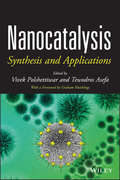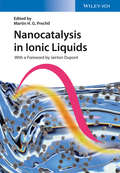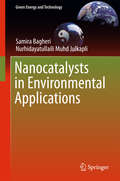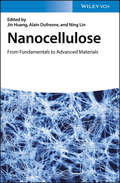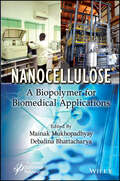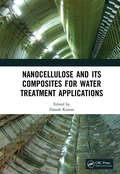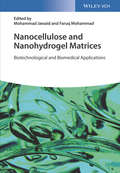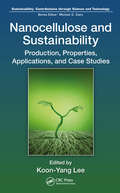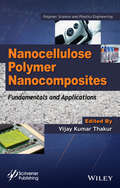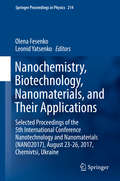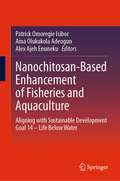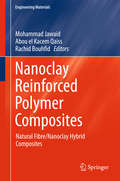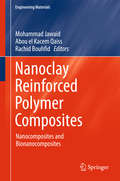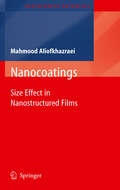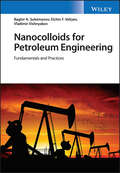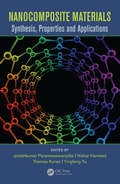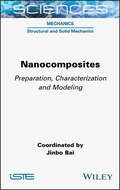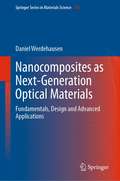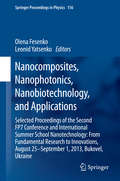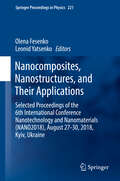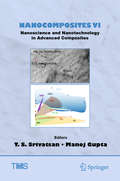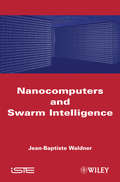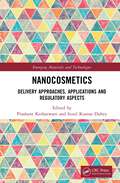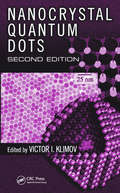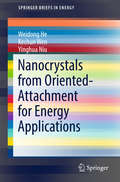- Table View
- List View
Nanocatalysis
by Vivek Polshettiwar Tewodros Asefa Graham HutchingsExhibiting both homogeneous and heterogeneous catalytic properties, nanocatalysts allow for rapid and selective chemical transformations, with the benefits of excellent product yield and ease of catalyst separation and recovery. This book reviews the catalytic performance and the synthesis and characterization of nanocatalysts, examining the current state of the art and pointing the way towards new avenues of research. Moreover, the authors discuss new and emerging applications of nanocatalysts and nanocatalysis, from pharmaceuticals to fine chemicals to renewable energy to biotransformations.Nanocatalysis features contributions from leading research groups around the world. These contributions reflect a thorough review of the current literature as well as the authors' first-hand experience designing and synthesizing nanocatalysts and developing new applications for them. The book's nineteen chapters offer a broad perspective, covering:Nanocatalysis for carbon-carbon and carbon-heteroatom coupling reactionsNanocatalysis for various organic transformations in fine chemical synthesisNanocatalysis for oxidation, hydrogenation, and other related reactionsNanomaterial-based photocatalysis and biocatalysisNanocatalysts to produce non-conventional energy such as hydrogen and biofuelsNanocatalysts and nano-biocatalysts in the chemical industryReaders will also learn about the latest spectroscopic and microscopy tools used in advanced characterization methods that shed new light on nanocatalysts and nanocatalysis. Moreover, the authors offer expert advice to help readers develop strategies to improve catalytic performance.Summarizing and reviewing all the most important advances in nanocatalysis over the last two decades, this book explains the many advantages of nanocatalysts over conventional homogeneous and heterogeneous catalysts, providing the information and guidance needed for designing green, sustainable catalytic processes.
Nanocatalysis in Ionic Liquids
by Jairton Dupont Martin H. PrechtlEdited and written by renowned experts in the field, this is the first book to reflect the state of the art of nanocatalysis in ionic liquids. Divided into two core areas, the first part of the book describes the different classes of metal nanoparticles as well as their synthesis in ionic liquids, while the second focuses on such emerging issues as the application of such systems to energy and biomass conversion.
Nanocatalysts in Environmental Applications (Green Energy and Technology)
by Nurhidayatullaili Muhd Julkapli Samira BagheriThis book presents a range of nanocatalysts, together with their primary environmental applications and use in chemical production processes. In addition, it describes the nanomaterials used for catalysts and details their performance.The book introduces readers to the fundamentals and applications of nanocatalysis, synthesis, characterization, modification and application. Further topics include: landfill organic pollutant photodegradation; magnetic photocatalysis; synergistic effects on hydrogenated TiO2; and photoinduced fusion of gold-semiconductor nanoparticles.A detailed explanation of the chemistry of nanostructures and the ability to control materials at the nano-scale rounds out the coverage. Given the central importance of research in nanotechnology and nanoscience for the development of new catalysts, the book offers a valuable source of information for researchers and academics alike. It will also benefit industrial engineers and production managers who wish to understand the environmental impact of nanocatalysts.
Nanocellulose: From Fundamentals to Advanced Materials
by Alain Dufresne Jin Huang Ning LinComprehensively introduces readers to the production, modifications, and applications of nanocellulose This book gives a thorough introduction to the structure, properties, surface modification, theory, mechanism of composites, and functional materials derived from nanocellulose. It also provides in-depth descriptions of plastics, composites, and functional nanomaterials specifically derived from cellulose nanocrystals, cellulose nanofibrils, and bacterial cellulose. It includes the most recent progress in developing a conceptual framework of nanocellulose, as well as its numerous applications in the design and manufacture of nanocomposites and functional nanomaterials. The book also looks at the relationship between structure and properties. Featuring contributions from many noted experts in the field, Nanocellulose: From Fundamentals to Advanced Materials examines the current status of nanocomposites based on nanocelluloses. It covers surface modification of nanocellulose in the nanocomposites development; reinforcing mechanism of cellulose nanocrystals in nanocomposites; and advanced materials based on self-organization of cellulose nanocrystals. The book studies the role of cellulose nanofibrils in nanocomposites, as well as a potential application based on colloidal properties of cellulose nanocrystals. It also offers strategies to explore biomedical applications of nanocellulose. -Provides comprehensive knowledge on the topic of nanocellulose, including the preparation, structure, properties, surface modification and strategy -Covers new reports on the application of nanocellulose -Summarizes three kinds of nanocellulose (cellulose nanocrystals, cellulose nanofibrils, and bacterial cellulose) and their production, modification, and applications Nanocellulose: From Fundamentals to Advanced Materials is a useful resource for specialist researchers of chemistry, materials, and nanotechnology science, as well as for researchers and students of the subject.
Nanocellulose: A Biopolymer for Biomedical Applications
by Mainak Mukhopadhyay Debalina BhattacharyaNANOCELLULOSE This book provides the latest up-to-date information on the exciting applications of nanocellulose in human diseases by giving in-depth explanations of their synthesis, characterization, and real-world applications in the biomedical sectors. Nanocellulose is a promising nanomaterial with unique qualities including low cost, durability, non-toxicity, accessibility, etc. Cellulose can be classified into two types: nanocrystals and nanofibrils, depending on the way it is extracted from trees, plants, or other cellulose-containing species. Textiles, cosmetics, and food products are just a few of the commercial uses for nanocellulose. However, it also has strong potential for use in medicine. The book presents the most recent scientific research on nanocellulose as a biopolymer and its potential uses in medicine. The reader will discover: explains the synthesis of bacterial nanocellulose from different bacterial species and their characteristics; details processes and applications of electrospinning and the synthesis of novel nanocellulose-based nanocomposite materials; discusses the various surface functionalization processes of cellulose and their advantages and disadvantages; delves into the application of nanocellulose in tissue engineering and grafting, such as in wound dressing and implants; discusses nanocellulose as a carrier for drug delivery, as well as the synthesis of antibacterial nanocomposites for treating multi-drug-resistant bacteria; explores the role of nanocellulose in the treatment of renal failure, nanocellulose hydrogel for ophthalmic and dental applications. Audience Researchers in areas including environmental biotechnology, bioprocess engineering, renewable energy, chemical engineering, nanotechnology, biotechnology, and microbiology will be interested in this book.
Nanocellulose and Its Composites for Water Treatment Applications
by Dinesh KumarBiological materials and their applications have drawn increasing attention among scientists. Cellulose is an abundant, renewable, biodegradable, economical, thermally stable, and light material, and it has found application in pharmaceuticals, coatings, food, textiles, laminates, sensors, actuators, flexible electronics, and flexible displays. Its nano form has extraordinary surface properties, such as higher surface area than cellulose; hence, nanocellulose can be used as a substitute for cellulose. Among many other sustainable, functional nanomaterials, nanocellulose is attracting growing interest in environmental remediation technologies because of its many unique properties and functionalities. Nanocellulose and Its Composites for Water Treatment Applications supplies insight into the application of nanocellulose and its nanocomposites for water purification and remediation. It covers different classes of nanocellulose—cellulose nanocrystal (CNC), microfibrillated cellulose (MFC), hairy cellulose nanocrystalloid (HCNC), and bacterial nanocellulose (BNC)—for their competency with other renewable and carbonaceous materials such as pectin, alginate, and CNTs. Future perspectives of nanocellulose and nanocomposites gleaned from different biodegradable origins are also discussed. This book delves into an updated description of the basic principles and developments in synthesis, characterization methods, properties (chemical, thermal, optical, structural, surface, and mechanical structure), property relationships, crystallization behavior, and degradability of biodegradable nanocomposites. The book also supplies vivid information about various cellulose nanomaterials and their applications in absorbing organic and inorganic toxins, membrane filtration of bacteria, viruses, and ionic impurities, photocatalytic dye removal, and sensing of water toxins. Features Details the synthesis and characterization methods of nanocellulose Illustrates the applications of nanocellulose and its nanocomposites Shows in-depth accounts of the various types of properties of nanocellulose and its composites Features emerging trends in the use of nanocellulose as adsorbents, sensors, membranes, and photocatalysis materials This book will be useful for academics, researchers, and engineers working in water treatment and purification.
Nanocellulose and Nanohydrogel Matrices: Biotechnological and Biomedical Applications
by Mohammad Jawaid Faruq MohammadThis first book on nanocellulose and nanohydrogels for biomedical applications is unique in discussing recent advancements in the field, resulting in a comprehensive, well-structured overview of nanocellulose and nanohydrogel materials based nanocomposites. The book covers different types of nanocellulose materials and their recent developments in the drug delivery and nanomedicine sector, along with synthesis, characterization, as well as applications in the biotechnological and biomedical fields. The book also covers the current status and future perspectives of bacterial cellulose and polyester hydrogel matrices, their preparation, characterization, and tissue engineering applications of water soluble hydrogel matrices obtained from biodegradable sources. In addition, the chitosan-based hydrogel and nanogel matrices, their involvement in the current biofabrication technologies, and influencing factors towards the biomedical sector of biosensors, biopharmaceuticals, tissue engineering appliances, implant materials, diagnostic probes and surgical aids are very well documented. Further, the history of cellulose-based and conducting polymer-based nanohydrogels, their classification, synthesis methods and applicability to different sectors, the challenges associated with their use, recent advances on the inhibitors of apoptosis proteins are also included. The recent developments and applications in the drug delivery sector gives an overview of facts about the nanofibrillated cellulose and copoly(amino acid) hydrogel matrices in the biotechnology and biomedicine field. This book serves as an essential reference for researchers and academics in chemistry, pharmacy, microbiology, materials science and biomedical engineering.
Nanocellulose and Sustainability: Production, Properties, Applications, and Case Studies (Sustainability: Contributions through Science and Technology)
by Koon-Yang LeeNanometre scale cellulose fibres, or nanocellulose, are emerging materials for various advanced applications. Nanocellulose and Sustainability: Production, Properties, Applications, and Case Studies provides a comprehensive overview of nanocellulose production, nanocellulose properties and nanocellulose in selected applications. This book serves as an entry level reference text for undergraduates, graduate students, researchers and professional engineers working in the area of nanocellulose and sustainability. Features: Summarises the surface and bulk properties of various types of nanocellulose Reviews the application of nanocellulose in water purification and optically transparent materials Provides an overview of nanocellulose as Pickering emulsifier, binder for loose natural fibres to produce non-woven preforms, as well as nanocellulose-based aerogels Presents a techno-economic analysis of industrial bacterial cellulose production Discusses the pilot scale production of cellulose nanocrystals
Nanocellulose Polymer Nanocomposites
by Vijay Kumar ThakurBiorenewable polymers based nanomaterials are rapidly emerging as one of the most fascinating materials for multifunctional applications. Among biorenewable polymers, cellulose based nanomaterials are of great importance due to their inherent advantages such as environmental friendliness, biodegradability, biocompatibility, easy processing and cost effectiveness, to name a few. They may be produced from biological systems such as plants or be chemically synthesised from biological materials. This book summarizes the recent remarkable achievements witnessed in green technology of cellulose based nanomaterials in different fields ranging from biomedical to automotive. This book also discusses the extensive research developments for next generation nanocellulose-based polymer nanocomposites. The book contains seventeen chapters and each chapter addresses some specific issues related to nanocellulose and also demonstrates the real potentialities of these nanomaterials in different domains. The key features of the book are:Synthesis and chemistry of nanocellulose from different biorenewable resourcesDifferent characterization of nanocellulosic materials and their respective polymer nanocompositesPhysico-chemical, thermal and mechanical investigation of nanocellulose based polymer nanocompositesProvides elementary information and rich understanding of the present state-of- art of nanocellulose-based materialsExplores the full range of applications of different nanocellulose-based materials.
Nanochemistry, Biotechnology, Nanomaterials, and Their Applications: Selected Proceedings of the 5th International Conference Nanotechnology and Nanomaterials (NANO2017), August 23-26, 2017, Chernivtsi, Ukraine (Springer Proceedings in Physics #214)
by Olena Fesenko Leonid YatsenkoThis book presents some of the latest achievements in nanotechnology and nanomaterials from leading researchers in Ukraine, Europe, and beyond. It features selected peer-reviewed contributions from participants in the 5th International Science and Practice Conference Nanotechnology and Nanomaterials (NANO2017) held in Chernivtsi, Ukraine on August 23-26, 2017. The International Conference was organized jointly by the Institute of Physics of the National Academy of Sciences of Ukraine, Ivan Franko National University of Lviv (Ukraine), University of Tartu (Estonia), University of Turin (Italy), and Pierre and Marie Curie University (France). Internationally recognized experts from a wide range of universities and research institutions share their knowledge and key results on topics ranging from energy storage to biomedical applications. This book's companion volume also addresses nanooptics, nanoplasmonics, and interface studies.
Nanochitosan-Based Enhancement of Fisheries and Aquaculture: Aligning with Sustainable Development Goal 14 – Life Below Water
by Patrick Omoregie Isibor Aina Olukukola Adeogun Alex Ajeh EnunekuNanochitosan-Based Enhancement of Fisheries and Aquaculture: Aligning with Sustainable Development Goal 14 – Life Below Water is an indispensable guide for envisioning an ecologically balanced and prosperous future for aquatic resource management. The book explores the innovative application of nanochitosan in aquatic resource management, delineating the cutting-edge potentials of the novel biopolymer to reshape the landscape of fisheries and aquaculture and align with the ambitions of the United Nations Sustainable Development Goals (Goal 14: Life Below Water). The book focuses on sustainability and showcases nanochitosan's capacity to elevate water quality, bolster aquatic well-being, and revolutionize aquaculture disease control, breeding, detoxification, and feed quality. Through practical applications, interdisciplinary insights, and a strong emphasis on food safety and conservation, readers gain a multifaceted understanding of thefield's advancements, future potential, challenges, and requisite nanochitosan-based techniques. This work navigates complex scientific concepts clearly, catering to a diverse audience, including researchers, practitioners, and students.
Nanoclay Reinforced Polymer Composites
by Mohammad Jawaid Abou el Kacem Qaiss Rachid BouhfidThis book highlights the most essential advances innanoclay-based nanocomposites, especially natural fibre-reinforced polymercomposites. Readers will find extensive information on nanoclay frompreparation to applications, and the characterization techniques needed inorder to evaluate the resulting properties of nanoclay-based natural fibre-reinforcedpolymer composites. Topics covered include the characterization of nano-sizedclay, chemical modification, and processing techniques for nanocomposites fromnanoclay. The book offers a valuable reference guide for academics andindustrial practitioners alike.
Nanoclay Reinforced Polymer Composites
by Mohammad Jawaid Abou el Kacem Qaiss Rachid BouhfidThis book is part of a two-volume book series that exhaustively reviews the key recent research into nanoclay reinforced polymer composites. This second volume focuses on nanoclay based nanocomposites and bionanocomposites fabrication, characterization and applications. This includes classification of nanoclay, chemical modification and processing techniques of nanocomposites. The book also provides comprehensive information about nanoclay modification and functionalization; modification of nanoclay systems, geological and mineralogical research on clays suitability; bio-nanocomposites based on nanoclays; modelling of mechanical behaviour of halloysite based composites; mechanical and thermal properties of halloysite nanocomposites; the effect of Nanoclays on gas barrier properties of polymers and modified nanocomposites. This book is a valuable reference guide for academics and industrial practitioners alike.
Nanocoatings
by Mahmood AliofkhazraeiSize effect in structures has been taken into consideration over the last years. In comparison with coatings with micrometer-ranged thickness, nanostructured coatings usually enjoy better and appropriate properties, such as strength and resistance. These coatings enjoy unique magnetic properties and are used with the aim of producing surfaces resistant against erosion, lubricant system, cutting tools, manufacturing hardened sporadic alloys, being resistant against oxidation and corrosion. This book reviews researches on fabrication and classification of nanostructured coatings with focus on size effect in nanometric scale. Size effect on electrochemical, mechanical and physical properties of nanocoatings are presented.
Nanocolloids for Petroleum Engineering: Fundamentals and Practices
by Baghir A. Suleimanov Elchin F. Veliyev Vladimir VishnyakovNanocolloids for Petroleum Engineering Enables readers to understand nanocolloids in upstream operations in the oil industry from an applied and theoretical point of view Nanocolloids for Petroleum Engineering brings together the background, latest advances, and practical and theoretical information about nanocolloids for petroleum engineering in one comprehensive volume. The text is structured in such a way to allow readers to easily distinguish key points and quickly gain the expertise they need to become more effective in their respective disciplines. For practical purposes and to aid in seamless reader comprehension, experiences of service companies, general guidance, and problem solving exercises are included throughout the text. The highly qualified authors specifically present the subject as petroleum experts and use a niche industry point of view, which means petroleum, reservoir, and drilling engineers will be able to quickly understand and digest the information contained within. Sample topics covered in the work include: A brief introduction to and classification of colloid systems, describing the main properties of nanocolloids crucial for practical application in petroleum engineering Nanocolloids application in reservoir engineering and development, illustrating reservoir conditions necessary for nanocolloids formation Nanocolloid applications in production operations, including the mechanism of nanoscale dispersion phase impact on physical properties of conventional substances utilized in upstream processes Nanocolloid application in Enhanced Oil Recovery (EOR) and the impact of nanoparticles on conventional displacement agents Nanocolloids for Petroleum Engineering serves as a comprehensive reference work and standalone guide for petroleum engineers who are interested in gaining knowledge surrounding nanocolloids and harnessing that knowledge to aid in solving a wide variety of conventional challenges in the field.
Nanocomposite Materials: Synthesis, Properties and Applications (Woodhead Publishing Series In Composites Science And Engineering Ser.)
by Jyotishkumar Parameswaranpillai Nishar Hameed Thomas Kurian Yingfeng YuThis book provides a comprehensive collection of the latest information on nanomaterials and nanocomposites. It covers material synthesis, processing, structure characterization, properties and applications. It presents a coherent treatment of how composite properties depend on nanostructure, and covers cutting-edge topics like bionanocomposites for sustainable development. This book summarizes many developments in the field making it an ideal resource for researchers from industry, academia, government and private research institutions.
Nanocomposites: Preparation, Characterization and Modeling
by Jinbo BaiNanocomposites are one of the major advances in the field of materials. They have applications in sectors as varied as aeronautics, energy and the environment. However, the effective use of nanocomposites requires new knowledge and tools in order to overcome the difficulties and benefit from the advantages. Nanocomposites presents recent academic and industrial progress in this field, as well as the latest research on the effective use of nanoscale fillers and reinforcements to improve the performance of advanced nanocomposites. It also describes the techniques and tools used to prepare nanocomposites, including the latest techniques for synthesis and surface treatment of nanofillers for different applications. Finally, it details the role of nanoscience in the design, characterization and multi-scale modeling of these materials, with a focus on nanoscale phenomena.
Nanocomposites as Next-Generation Optical Materials: Fundamentals, Design and Advanced Applications (Springer Series in Materials Science #316)
by Daniel WerdehausenThis book looks at advanced nanocomposites, introducing long-awaited concepts towards bridging the gap between nanostructured optical materials and next-generation imaging systems. It investigates nanocomposites as bulk optical materials and highlights the immense potential they hold for real-world optical elements and systems, such as smartphone cameras. It covers the full spectrum of nanocomposite optical materials from their fundamental properties to analytical modeling and detailed application examples. This book also provides an in-depth discussion of the role these new materials play in the development of broadband flat optics – diffractive optical elements used for enhancing high-end broadband imaging systems. Written by an industry expert, this book seamlessly connects fundamental research and real-world applications. It is the ideal guide both for optical engineers working towards integrating new technologies, and researchers involved with fundamental research on optical materials.
Nanocomposites, Nanophotonics, Nanobiotechnology, and Applications
by Olena Fesenko Leonid YatsenkoThis book presents some of the latest achievements in nanotechnology and nanomaterials from leading researchers in Ukraine, Europe, and beyond. It features contributions from participants in the 2nd International Summer School "Nanotechnology: From Fundamental Research to Innovations" and International Research and Practice Conference "Nanotechnology and Nanomaterials", NANO-2013, which were held in Bukovel, Ukraine on August 25-September 1, 2013. These events took place within the framework of the European Commission FP7 project Nanotwinning, and were organized jointly by the Institute of Physics of the National Academy of Sciences of Ukraine, University of Tartu (Estonia), University of Turin (Italy), and Pierre and Marie Curie University (France). Internationally recognized experts from a wide range of universities and research institutions share their knowledge and key results on topics ranging from nanooptics, nanoplasmonics, and interface studies to energy storage and biomedical applications.
Nanocomposites, Nanostructures, and Their Applications: Selected Proceedings of the 6th International Conference Nanotechnology and Nanomaterials (NANO2018), August 27-30, 2018, Kyiv, Ukraine (Springer Proceedings in Physics #221)
by Olena Fesenko Leonid YatsenkoThis book highlights some of the latest advances in nanotechnology and nanomaterials from leading researchers in Ukraine, Europe, and beyond. It features contributions from participants in the 6th International Science and Practice Conference Nanotechnology and Nanomaterials (NANO2018) in Kiev, Ukraine on August 27-30, 2018 organized by the Institute of Physics of the National Academy of Sciences of Ukraine, University of Tartu (Estonia), University of Turin (Italy), and Pierre and Marie Curie University (France). Internationally recognized experts from a wide range of universities and research institutions share their knowledge and key results on material properties, behavior, and synthesis. This book's companion volume also addresses topics such as nanooptics, energy storage, and biomedical applications.
Nanocomposites VI: Nanoscience and Nanotechnology in Advanced Composites (The Minerals, Metals & Materials Series)
by Manoj Gupta T. S. SrivatsanThis volume presents novel and innovative contributions in the domain specific to nanocomposites, specifically on aspects both related and relevant to the following: · science at the nanoscale level · innovations and advances in processing · characterization, quantification, and analysis · mechanical property evaluation and rationalization · failure analysis · technological applications at the nanoscale level The collection brings together a range of developments in areas spanning basic science, processing, analysis, characterization, mechanical property evaluation, and failure analysis rationalization of composite materials.
Nanocomputers and Swarm Intelligence
by Jean-Baptiste WaldnerFor the last 50 years, the power of integrated circuits has continued to grow. However, this performance will end up reaching its physical limit. What new ways will then be available to develop even more powerful and up-to-date systems? This book introduces the principles of quantic computing, the use of nano-tubes in molecular transistors and ADN computing. It suggests new fabrication methods for the 21st century and introduces new architecture models, ranging from the most conventional to the most radical. Using a chronological theme, it explains our unavoidable entry in the nano-device world: from the 1948 transistor to the microchip. It concludes by anticipating the changes in daily living: investments, impact on coding activities, nanocomputing systems implementation and IT job mutation.
Nanocosmetics Delivery Approaches, Applications and Regulatory Aspects: Delivery Approaches, Applications And Regulatory Aspects (Emerging Materials and Technologies)
by Prashant Kesharwani Sunil Kumar DubeyThis book offers an overview of the science of cosmetics and the formulation of nanosized cosmetic products including fabrication, characterization of nanocosmetics, major challenges in the safe applications, regulatory aspects, and commercialization on a large scale. The chapters provide understanding of the interaction of nanocarriers with skin and hair, different nanocosmetic products in the present situation, applications as well as disadvantageous toxicity associated with nanocosmetics, regulatory prospects, and future perspectives. Features: Provide an explicit account on vital aspects of various nanocosmetics drug delivery approaches, thereby providing a next-generation cosmetic product. Bring together the novel applications of nanocosmetics approaches in the biological milieu. Explores preparation, applications, toxicity, and regulatory prospects. Includes a dedicated chapter on Niosomal drug-delivery systems in cosmetics. Discusses the perspectives of the technologies explored so far based upon the findings outlined in highly organized tables, illustrative figures, and flow charts. This book is aimed at researchers and professionals in nanomedicine, pharmaceuticals, biotechnology, and the health sector.
Nanocrystal Quantum Dots
by Victor I. KlimovA review of recent advancements in colloidal nanocrystals and quantum-confined nanostructures, Nanocrystal Quantum Dots is the second edition of Semiconductor and Metal Nanocrystals: Synthesis and Electronic and Optical Properties, originally published in 2003. This new title reflects the book’s altered focus on semiconductor nanocrystals. Gathering contributions from leading researchers, this book contains new chapters on carrier multiplication (generation of multiexcitons by single photons), doping of semiconductor nanocrystals, and applications of nanocrystals in biology. Other updates include: New insights regarding the underlying mechanisms supporting colloidal nanocrystal growth A revised general overview of multiexciton phenomena, including spectral and dynamical signatures of multiexcitons in transient absorption and photoluminescence Analysis of nanocrystal-specific features of multiexciton recombination A review of the status of new field of carrier multiplication Expanded coverage of theory, covering the regime of high-charge densities New results on quantum dots of lead chalcogenides, with a focus studies of carrier multiplication and the latest results regarding Schottky junction solar cells Presents useful examples to illustrate applications of nanocrystals in biological labeling, imaging, and diagnostics The book also includes a review of recent progress made in biological applications of colloidal nanocrystals, as well as a comparative analysis of the advantages and limitations of techniques for preparing biocompatible quantum dots. The authors summarize the latest developments in the synthesis and understanding of magnetically doped semiconductor nanocrystals, and they present a detailed discussion of issues related to the synthesis, magneto-optics, and photoluminescence of doped colloidal nanocrystals as well. A valuable addition to the pantheon of literature in the field of nanoscience, this book presents pioneering research from experts whose work has led to the numerous advances of the past several years.
Nanocrystals from Oriented-Attachment for Energy Applications (SpringerBriefs in Energy)
by Weidong He Kechun Wen Yinghua NiuThis brief provides a comprehensive overview of contemporary research and materials technologies utilizing oriented-attachment nanocrystals (OA NCs) for the energy conversion devices. Starting with a historical introduction, the book presents basic theory with an emphasis on thermodynamic and kinetic models of the oriented-attachment nanocrystals growth. Further chapters review recent advances in the synthesis, characterization, and application of the oriented-attachment nanocrystals in fuel cells, batteries, supercapacitors, solar cells and photocatalysis. This book will appeal to researchers and scholars from a variety of disciplines including electrochemistry, materials science, chemical engineering, physics and mechanical engineering.
